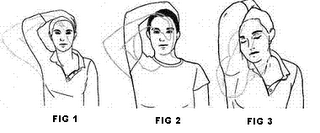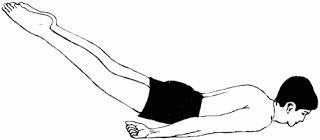Exercises & Yoga for Cervical Spondylosis and
Neck Pain
Here are basic
stretches and exercises that can be used by almost everyone in pain,
though you should always consult your doctor before beginning an
exercise plan. Take 10-15 minutes a day and go through the entire
routine for maximum relief.
For each of the neck
exercises, you should be seated comfortably with your shoulders, neck, and
jaw as relaxed as possible.
Reach your right arm over your head so that
your palm is on top of your skull, your fingers resting just above
the left ear. Allow the weight of your arm, along with light fingertip
pressure, to gently bend the head toward your right shoulder (fig.1).
|
|
Do not strain. Check to make sure your shoulders are still relaxed. You
should be looking forward. Hold the pose for 30 seconds. Move your fingers
toward the back left corner of your skull, this time allowing your head to
bend forward and to the right, about 45 degrees in front of your shoulder (fig.2). Hold for 30 seconds. Now place your fingers at the back of your
skull and gently pull your head straight forward, toward your chest (fig.3). Hold for 30 seconds. Switch hands and repeat the stretches in
reverse order: Pull forward, then 45 degrees in front of your left shoulder,
and finally directly over your left shoulder. Do not push your head
backward.

_______________________________________________________
Do an
isometric push against your hand to strengthen the neck. Hold your left palm
against the left side of your head (fig.4). Push your left hand
against your head while also pushing your head toward your left hand at
about half strength. Hold for 30 seconds. Repeat with your right hand on the
right side of the head. Do the same exercise, using either hand, with the
back of the head (fig.5) and the forehead (fig.6).

_______________________________________________________
Yoga
for Cervical Spondylosis - Yoga for Chronic Neck Pain
If you determine you simply have a stiff
neck, specific yoga exercises will help strengthen muscles and increase
flexibility in the neck. Even gently exercising your neck helps lubricate
and speed nutrients to the area. Here are a few exercises for your neck that
are particularly helpful.
Neck
Stretches
Follow these steps when practicing neck
stretches:
Start in seated position (cross legged)
Sit up tall, reaching up through the top
of the head
Draw shoulders back
Exhale, drop chin towards chest, keeping
elbows and shoulders pulled back
Inhale, raise the head back to center
Do this five times, then on the last
exhale, drop the chin and stay in this position for three breaths, breathing
through the nose
Inhale, raise head back to center
Exhale, slowly drop right ear towards
right shoulder
Inhale, raise head back to center
Do this five times, then on the last
exhale, drop the ear towards the right shoulder and stay in this position
for 3 breaths
Inhale, raise head back to center
Repeat on left side
If
you continue to have a neck pain, your first task is to learn to reestablish
a normal curve in as many situations as possible: sitting at your desk,
standing in line at the grocery store, lying in bed.If done properly, all
backward bends except Sethu Bandha Sarvangasana (Bridge Pose) engage your
neck extensor muscles.

Asanas like Salabhasana (Locust Pose) and Bhujangasana (Cobra Pose)
backbends in which the weight of the head is lifted against gravity
provide the most strengthening benefits for the back of the neck muscles.
However, as you practice these asanas, see that you pull your shoulder
blades away from your ears and do not to compress the back of your neck.
Try
to feel as if the cervical curve is distributed evenly throughout your
entire neck and you're stretching your neck, even as you bend it backwards.

Bhujangasana (Cobra
Pose)

____________________________________________________________
 Locust Pose
Locust Pose
______________________________________________________
Sarvangasana (Shoulderstand) can worsen the
problem. As the pose drops your chin toward your chest, it makes it very
easy to completely flatten the cervical curve or even curve the neck in the
wrong direction. So, if you have a fairly recent, still painful, and acute
neck injury like whiplash from an auto accident, avoid Shoulderstand. It
would only exacerbate the injury, and practicing it too soon could
significantly prolong your healing time.
Sarvangasana (Shoulderstand)


______________________________________________________
Half-Circles

Half circles in the front can be done
instead. To do this, first drop your chin to your chest. Move your chin
towards the right shoulder then back to your chest. Then move your chin
towards the left shoulder and back towards the chest. Repeat this movement
three to five times.
______________________________________________________
Shoulder
Moves
Hunch your shoulders as high as possible, then let them relax completely.
Repeat this movement 5-6 times. Next, roll your shoulders in a backwards
circular motion (lifting shoulders up, squeezing them back, dropping them
down and then bringing them forward again). Repeat this motion 5-6 times,
then move your shoulders in a forward circular motion. All these shoulder
movements help to relax the muscles in your neck and upper back. Many of us
hunch our shoulders unconsciously much of the time. Notice how they feel
when they are relaxed and try to keep them this way.
____________________________________________
Chest
Expander
Stand up with your feet
close together. Bring your hands behind your back and interlace your
fingers. Tuck your tailbone in, so you dont arch your low back too much. As
you inhale, lift your hands away from your tailbone. Squeeze your shoulder
blades together and you lift your arms and stay in this position for 3-4
breaths. On your next exhale, lower your arms back down. This exercise helps
strengthen the muscles in your upper back and relieve tension in your upper
back and shoulders.
____________________________________________
Arm Lifts
Bring your arms straight out in front of you
with your palms facing each other. As you inhale, reach your arms overhead,
bringing your arms next to your ears, if you can do so without any pain. As you
exhale, bring your arms back down in front of you. Repeat 4-8 times. This helps
to relieve tension and build strength in the muscles in the upper back.
____________________________________________
Press It
Place the palms of your hand against the back
of your head and gently press while resisting with your head. Hold for a count
of ten. Repeat with your palm on your forehead.
_________________________________________________

|